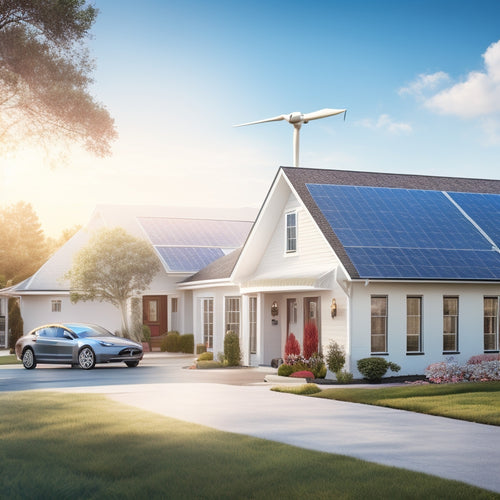
Solar Panel Costs for Small Homeowners Revealed
Share
As a small homeowner, you're likely to pay between $15,000 and $30,000 for a solar panel system, but the actual cost depends on factors like system size, roof size, and local incentives, all of which can greatly impact the final price tag. Your roof's size, shape, and obstacles will affect the number of panels needed, while the system's size and energy density will influence the overall cost. To gain a clear understanding of the costs involved, evaluate all these factors. As you explore your options, you'll discover how each element affects the bottom line, and what you can expect from your investment.
Key Takeaways
• System size significantly affects the overall cost, with larger systems costing less per watt than smaller ones, making smaller systems more expensive.
• Roof size and shape impact the number of solar panels needed, with roof obstacles like chimneys and vents reducing available space.
• Installation labor costs vary depending on complexity and installer rates, with permitting fees adding to the overall expense.
• Federal tax credits and local incentives can substantially reduce upfront expenses, making solar energy more accessible to small homeowners.
• Energy efficiency and savings from solar panels can reduce energy bills by hundreds of dollars annually, providing a strong ROI for small homeowners.
Understanding Solar Panel Pricing
When researching solar panel prices, you'll likely encounter a wide range of quotes, making it essential to understand the factors that influence solar panel pricing.
Market trends, such as supply and demand, play a significant role in shaping the prices of solar panels. As demand increases, prices tend to decrease, and vice versa.
Industry standards, such as those set by the International Electrotechnical Commission (IEC), also impact pricing. These standards guarantee that solar panels meet certain quality and performance requirements, which can affect their cost.
Understanding these factors will help you navigate the complex landscape of solar panel pricing.
You'll be better equipped to compare quotes from different manufacturers and installers, and to identify the best value for your money. By considering market trends and industry standards, you'll gain control over the purchasing process and make informed decisions about your solar panel investment.
With a clear understanding of the pricing factors, you'll be able to optimize your solar panel system to meet your energy needs and budget.
System Size and Cost Factors
As you explore solar panel pricing, you'll find that system size is a key cost factor, with larger systems requiring more panels and hardware, thereby increasing the overall expense. This is because larger systems need more components, such as inverters and mounting systems, which drive up costs.
However, vital to determining the ideal system size for your home is assessing energy density. Energy density refers to the amount of power generated per unit of surface area. A higher energy density means you can generate more power with fewer panels, reducing overall costs.
To achieve cost transparency, understanding how system size affects pricing is imperative. Be sure to ask your solar panel provider about the cost per watt, as this will give you a clear understanding of the system's cost-effectiveness. Additionally, inquire about any potential discounts or incentives for larger systems.
Average Cost of Solar Panels
As you explore the average cost of solar panels, you'll find that system size plays a significant role in determining the overall cost.
Generally, larger systems cost less per watt than smaller ones, which is why understanding the impact of system size is vital.
You'll also need to take into account the price per watt, which varies depending on the quality and efficiency of the panels.
System Size Impact
Determining the ideal system size for your solar panel installation substantially affects the overall cost, with larger systems requiring more panels and resulting in higher upfront expenses. As a homeowner, you need to consider your energy consumption patterns and available space to determine the optimal system size.
-
Energy consumption: Assess your past electricity bills to determine your average daily energy consumption. This will help you determine the required system size to meet your energy needs.
-
Space constraints: Evaluate the available roof space to determine the maximum system size that can be installed. This is crucial to ensure that your system is efficiently utilizing the available space.
-
System efficiency: Consider the efficiency of the solar panels and the inverter to ensure that your system is producing the maximum possible energy output.
Price Per Watt
The cost of a solar panel installation is substantially influenced by the price per watt, which is the average cost of solar panels, varying from $2.50 to $3.50 per watt depending on the quality and efficiency of the panels.
This price range is a result of market trends, where manufacturers and suppliers compete to offer the best value for homeowners. Industry standards dictate that high-efficiency panels typically cost more, while lower-efficiency panels are more budget-friendly.
As a homeowner, you'll want to weigh the type of panels you need, taking into account factors like energy output, durability, and warranty. High-quality panels may cost more upfront, but they'll provide better performance and longer lifespan, ultimately saving you money in the long run.
On the other hand, budget-friendly options may require more maintenance and replacement, adding to your overall costs.
When evaluating quotes from installers, be sure to verify the price per watt to guarantee you're getting the best deal. By understanding this key factor, you'll be better equipped to navigate the market and make an informed decision about your solar panel investment.
Installation Costs and Incentives
As you consider the total cost of solar panels, you'll need to factor in installation labor costs, which can vary depending on the complexity of the installation and the installer's rates.
Fortunately, you'll also want to explore the incentives available, such as federal tax credits, which can help offset the upfront costs.
Installation Labor Costs
You'll need to factor in installation labor costs, which typically range from $0.25 to $0.50 per watt, depending on the complexity of the installation and the installer's expertise. This cost can add up quickly, especially for larger systems.
Permitting fees can vary widely depending on your location. You'll need to obtain permits from your local government before installation can begin.
Labor shortages can drive up costs. If there's a shortage of qualified installers in your area, labor costs may be higher due to increased demand.
System complexity is another factor. If your installation requires specialized equipment or unique installation methods, labor costs will likely be higher.
Keep in mind that these costs can vary depending on your location, the size of your system, and the installer you choose. Be sure to get quotes from multiple installers to find the best deal. By understanding these costs, you can make an informed decision about your solar panel installation.
Federal Tax Credits
The federal government offers a tax credit of up to 26% of the total cost of your solar panel system, including installation, which can substantially reduce your upfront expenses.
You can claim this credit on your taxes, and it can notably offset the cost of your solar panel system. This tax benefit is a substantial incentive for homeowners like you to invest in solar energy.
The good news is that the credit extension has been approved until 2023, giving you ample time to plan and install your solar panel system.
You can claim the credit for the tax year in which you install your solar panel system. To qualify, your system must be installed and generating electricity during the tax year.
You'll need to keep records of your installation, including the cost, to claim the credit on your taxes. Don't miss out on this opportunity to reduce your tax liability and maximize your savings.
Roof Size and Panel Quantity
Your roof's size and shape play a significant role in determining the number of solar panels you'll need to install. A larger roof with minimal obstacles can accommodate more panels, while a smaller roof with multiple obstacles may require fewer panels.
When evaluating your roof, consider the following factors that affect panel quantity:
Roof Obstacles: Chimneys, vents, and skylights reduce the available space for solar panels, forcing you to cluster panels around these obstacles.
Panel Clustering: Clustering panels around obstacles increases the overall system cost due to the added complexity of the installation.
Roof Orientation and Tilt: A south-facing roof with a tilt between 30° and 40° is ideal for solar panels, but variations in orientation and tilt may require more or fewer panels.
Energy Efficiency and Savings
By investing in a solar panel system, homeowners can substantially reduce their reliance on the grid and lower their energy bills by hundreds of dollars annually.
You'll be able to monitor your energy production and consumption in real-time with Smart Meters, allowing you to make data-driven decisions to optimize your energy usage. Home Automation systems can also be integrated with your solar panel system, enabling you to control your energy usage remotely and automate energy-saving tasks.
As you generate your own clean energy, you'll reduce your reliance on the grid and decrease your energy bills. On average, homeowners can save between $400 to $1,000 per year on their energy bills.
Additionally, solar panels can increase your home's value, providing a strong selling point if you decide to sell in the future. By going solar, you'll not only reduce your energy costs but also contribute to a cleaner environment.
With a solar panel system, you'll have more control over your energy usage and costs. You'll be able to identify areas of energy inefficiency and make adjustments to optimize your energy usage.
Payback Period and ROI
As you invest in a solar panel system, you're likely wondering when you'll break even and start seeing a return on your investment. This is where a thorough financial analysis comes in, helping you determine the payback period and ROI of your solar panel system.
When evaluating the financial viability of your solar panel system, consider the following key factors:
System Cost: The upfront cost of purchasing and installing your solar panel system.
Energy Savings: The amount of money you'll save on your electricity bills each year.
Incentives and Rebates: Local and national incentives that can offset the initial cost of your system (we'll discuss these in more detail later).
Local Incentives and Rebates
Government agencies and utilities offer a range of local incentives and rebates to encourage the adoption of solar energy, helping to offset the upfront cost of your solar panel system.
As a homeowner, you can take advantage of these incentives to reduce the financial burden of going solar.
You may be eligible for State Grants, which provide funding for renewable energy projects, including solar installations. These grants can cover a significant portion of your solar panel system's cost, making it more affordable.
Additionally, you can explore Municipal Perks, such as property tax exemptions or low-interest loans, offered by your local government. These perks can help you save money on your solar panel system and increase your return on investment.
It's essential to research and understand the local incentives and rebates available in your area.
You can start by contacting your local government or utility company to learn more about the programs they offer.
Frequently Asked Questions
Can I Install Solar Panels on a Metal or Tile Roof?
You can install solar panels on a metal or tile roof, but verify the roof's structural integrity isn't compromised; assess roof compatibility beforehand to avoid potential issues and guarantee a secure installation.
Are There Any Financing Options for Solar Panel Systems?
As you navigate the solar panel landscape, you'll discover a rainbow of financing options, including loan options and government incentives, waiting to be harnessed, allowing you to seize control of your energy future.
Can I Sell Excess Energy Back to the Grid?
You can sell excess energy back to the grid through a process called net metering, which requires grid ties and energy harvesting systems, allowing you to offset your energy consumption and even earn credits.
Do Solar Panels Work During Power Outages?
You're wondering if solar panels work during power outages? In short, they typically don't, as they're grid-tied to maintain grid reliability and energy resilience, but with battery backup systems, you can achieve energy independence during outages.
Are Solar Panels Durable in Extreme Weather Conditions?
You're wondering if solar panels can withstand extreme weather? Relax, they're built to last! Manufacturers put them through rigorous climate testing to guarantee weather resistance, so you can rest easy knowing your panels will shine on, rain or shine!
Related Posts
-

Safety First: Why Seniors Need Advanced Vehicle Features
As you get behind the wheel, you're likely unaware that seniors are 16% more likely to be involved in a fatal car cra...
-

Why Homeowners Are Embracing DIY Energy Independence
By taking control of your energy needs, you're breaking free from the uncertainty of utility bills and embracing a se...
-

Safely Staying on Course: 5 Essential Lane Tips
You're about to take your driving skills to the next level by mastering the art of staying in your lane. First, inves...


